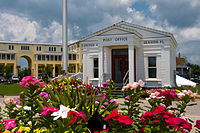
Photo from wikipedia
Cities are, among other things, especially dense concentrations of streets, avenues, and other corridors of movement. Streets serve as the equivalent of a skeletal system that structures urban form while… Click to show full abstract
Cities are, among other things, especially dense concentrations of streets, avenues, and other corridors of movement. Streets serve as the equivalent of a skeletal system that structures urban form while simultaneously framing movement and interaction through space. In fact, we commonly visualize, and simultaneously simplify, the city as a system of interconnected streets. These street maps, whether manifesting in physical, electronic, and mental forms, shape how we interact, imagine, and move through the urban landscape. Our ability to navigate is greatly enhanced by giving streets individualized names. Those names also provide a common frame of reference for communication with others, most obviously when giving directions. Combined with house or building numbers to create addresses, street names provide a basic framework for locating places in relation to other places and constitute ubiquitous but often overlooked infrastructural component of modern cities. Like other toponyms, street names appear superficially to function as mere spatial referents that identify and distinguish a particular street from other streets. A street’s name may also describe some distinguishing attribute and trait, such as a street lined with oak trees may be named Oak Street. In such cases, the process of naming streets appears relatively straightforward and hardly cause for controversy. Yet the process of street naming is inherently political and reflects the unequal distribution of social and economic capital. For example, it is common for street names to honor individuals, but that immediately raises a number of questions. What criteria will be used to judge which individuals are worthy of such an honor, for example, or which street is best suited to bear that person’s name? These questions are sorted out through political processes that invariably expose differences of opinion tied to competing values, beliefs, and priorities. Human geographers and cognate scientists have investigated the politics of street naming in a variety of geographical, historical, and social contexts, and in doing so, they have contributed to the burgeoning field of critical toponymy, or the critical study of place-naming processes. The Political Life of Urban Streetscapes: Naming, Politics, and Place, edited by Reuben Rose-Redwood, Derek Alderman, and Maoz Azaryahu, provides a broad and insightful overview of contemporary toponymic research by bringing together case studies from scholars with diverse disciplinary backgrounds. Collectively, the volume demonstrates that “the urban streetscape is a space where
Journal Title: Geographical Review
Year Published: 2019
Link to full text (if available)
Share on Social Media: Sign Up to like & get
recommendations!